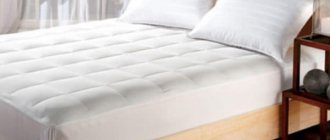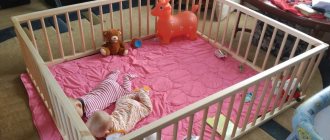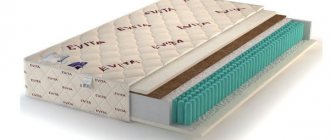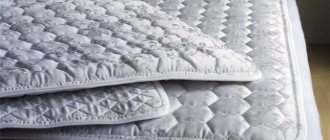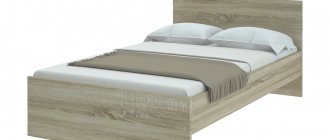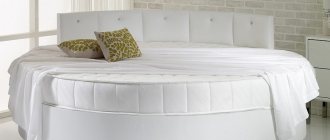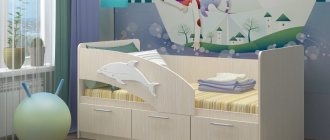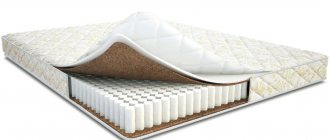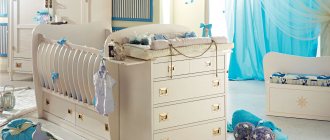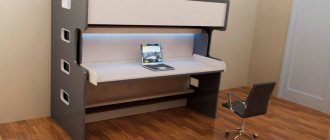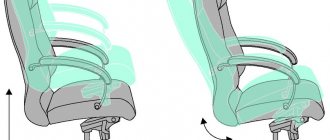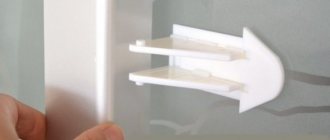The key to a strong and healthy child's sleep is the right choice of mattress. Manufacturers produce a wide range of models specifically for children, with various fillings, spring blocks and upholstery material. Therefore, before choosing the most suitable product for a baby crib, you need to study their features and use the recommendations of experts.
How to choose the right mattress by age
When choosing the most suitable mattress for a child, you should first take into account the age and accompanying physiological characteristics. For example, a model for a newborn should be rigid. They usually use coconut coir as a filler. It does not cause allergic reactions, despite the delicate and sensitive skin of a newborn. Coconut is characterized by increased density, so the filler made from it effectively supports the fragile spine, protecting it from possible curvatures.
It is recommended to buy spring mattresses for children for a child from 3 to 7 years old. The most widely used models are those with medium hardness. The filler is coconut coir in combination with latex, as well as polyurethane and other types of materials. They support the spine well, which is very important during the period of active growth of the baby. At the same time, tension in the neck and the headaches they cause are eliminated.
At the age of 7 to 10 years, the development of the child’s body continues. During this period, it is recommended to use models filled with special memory foam. It completely matches the contours of the body, ensuring the most comfortable and healthy sleep. Mattresses with independent springs have performed well, creating the most optimal rigidity and effectively removing accumulated loads.
Video review:
Children's mattress Dreamline Baby Dream 9 Gift
Orthopedic mattress for newborns. Three layers of coconut coir. Cover: quilted calico.
Buy
Price from 5,534 ₽ Installments from 461 ₽/month
Children's mattress Dreamline Baby Mix Slim -10%
Present
Springless orthopedic mattress with coconut and natural latex. Cotton Baby cover.
Buy
Price from 6,647 RUR 7,386 RUR (Save 739 RUR)
In installments from 553 ₽/month
Children's mattress Dreamline Baby Holl Hard Gift
Classic children's mattress with coconut coir and holofiber. Cover made of double-sided calico.
Buy
Price from 3,376 ₽ Installments from 281 ₽/month
Children's mattress Promtex Biba Combi Eco 9 -26%
Present
Inexpensive children's mattress with polyurethane foam and coconut coir. No springs. Thick polycotton cover.
Buy
Price from 5,925 ₽ 8,007 ₽ (Save 2,082 ₽)
In installments from 493 ₽/month
Children's mattress Promtex Biba Mark 12 -26%
Present
Double-sided springless mattress made from modern fillers. Inexpensive model. Polycotton cover.
Buy
Price from 5,017 RUR 6,780 RUR (Save 1,763 RUR)
In installments from 418 ₽/month
View all crib mattresses
Which mattress is better with natural or artificial filling?
When deciding how to choose a mattress for a child, the main attention should be paid to the filling material, which can be natural or artificial. Each of them has its own advantages and disadvantages, which determine the final cost of the product.
The advantages of natural fillers are the following:
- The use of natural materials - latex, coconut, cotton, linen, seaweed and others. They make the perfect mattress for a newborn.
- They have an optimal balance of softness and elasticity.
- Good breathability and ventilation properties.
The only serious drawback is the high cost of products with natural fillers.
Artificial materials are also very popular due to their qualities:
- Wide selection of fillers with different physical properties. Often used in the production of mattresses for middle-aged children.
- Hypoallergenic properties.
- Practicality, long service life.
- Low cost.
The disadvantages include rapid wear and deformation of some models. Budget products generally do not last long, especially those that consist of several layers.
What firmness mattresses are suitable for children of different ages?
Initially, the shape of the spine in a newborn is a configuration in the form of the letter C. Subsequently, the formation of S-shaped bends begins when the baby masters the initial movements. These processes continue until the age of 7, and throughout the entire period the question remains, how to choose a mattress for a child? After all, different age groups require products with varying degrees of rigidity.
How to choose a mattress for a newborn in a crib
From the moment of birth and over the next few months, newborns are constantly in a state of sleep. Therefore, it is very important to provide the baby with maximum convenience and comfort during this period.
Filler
It is this component that makes the mattress for a children's bed the right amount of hardness, elasticity and elasticity. It is recommended to give preference to natural materials that provide good air circulation and are resistant even to significant loads.
Polyurethane foam
This material is a type of foam rubber and differs from it in improved physical properties. This is a good filler with hypoallergenic properties. The porous structure promotes good air circulation, preventing the emergence and development of bacteria.
The density of different types of polyurethane can be adjusted, which allows you to obtain products with different degrees of rigidity. Due to this, it is quite easy to choose a children's mattress for any age group. Almost all models provide good support for the spine and fully correspond to the natural curves of the body. Children sleep on such mattresses very comfortably and comfortably.
Polyurethane memory foam
In essence, it is an improved elastic material with good anatomical properties based on Memory foam. Under the influence of body temperature, it softens and completely matches the contours of the child lying on it. After standing up, the mattress quickly returns to its original shape.
Thanks to these qualities, the internal organs do not experience any pressure. Such mattresses are perfect for children after 5 years of age, when the spine has almost formed and the development of the musculoskeletal system has moved to the next stage.
At first, children do not sleep very comfortably due to inconvenience when turning and excessive enveloping properties. However, after a short time, addiction sets in and sleep is completely normalized.
Latex
Natural latex is considered a high-quality, expensive filler. Artificial material is practically not inferior to it, but costs much less. The porous structure ensures high hygiene. Mattresses quickly get rid of moisture and are not saturated with foreign odors. High-quality thermoregulation allows you to feel comfortable at any time of the year.
Latex models are recommended for children aged 3 years and above. High elasticity creates normal support for the spine in a supine position. At the same time, the muscles completely relax, blood circulation is normalized, and the joints fully rest.
The size of the mattress must match the size of the crib
Depending on the age of the babies, cribs are divided into three groups: for newborns, for children aged three years and over and for teenagers. Each type has its own dimensions, and mattresses meet these standards:
- for newborns - 60x120 cm;
- for children over 3 years old - 80x160 cm;
- for teenagers - 80x180 cm.
A larger mattress cannot be placed flat on the crib base. The resulting folds create problems for the baby’s comfortable sleep, and can also lead to problems with the musculoskeletal system. A small mattress is also inconvenient: between it and the sides of the crib there is free space, into which the child’s arms or legs fall, which disturbs his restful sleep.
Ideally, it is recommended to purchase mattresses that are slightly smaller than the size of the crib, so that there is enough space around the edges for a mattress pad and bedding.
Upholstery
The mattress cover is of great importance, protecting the product from external influences. Therefore, special attention should be paid to the strength of the material on which the overall service life largely depends. The fabric should allow air to pass through well and make cleaning the mattress as easy as possible. The most practical are removable covers that can be easily removed for washing.
- Polyester. It belongs to the category of synthetic material and is entirely suitable as upholstery for a mattress. The fabric is wear-resistant, moisture-resistant and easy to clean. Recycled raw materials are often used to make polyester, so the material becomes additional environmentally friendly.
- Cotton. Natural product with high hypoallergenic properties. The material allows air to pass through well, is durable in use, but is less easy to clean compared to polyester.
- Mattress fabric. Combined fabric consisting of cotton and polyester. Combines the advantages of each of these materials.
- Lyocell. The basis of this synthetic material is a natural product – cellulose. Physical characteristics are similar to viscose and cotton. The structure feels soft and delicate, does not pill and provides good ventilation. The material itself is durable and easy to clean.
Requirements for children's mattresses
The choice of sleeping accessories and devices is associated with a number of difficulties and certain criteria:
When evaluating the fabric base, attention is paid not only to the internal filler, but also to the external upholstery. The quality of both components (cover and filler) must be of the highest quality: excellent environmental performance, minimal number of seams, absence of small parts. Small parts with rough, sharp edges can damage baby's delicate skin.It is important that the new purchase has orthopedic properties. The task of every parent is to try to maintain posture and normal blood supply to the brain as much as possible, even during sleep. In this case, children's orthopedic mattresses, specially developed by groups of medical specialists and designers, will be an excellent purchase.
A number of practical indicators: features of mattress care, the presence or absence of a removable cover, resistance to frequent washing and dry cleaning.
The cost of a particular model plays an important role in choosing a children's mattress.
The mattress must match the size of the base bed. Today, manufacturers of sleeping accessories produce not only standard size ranges of models (for example, a children's mattress 120 * 60 mm), but also models according to individual parameters.
Protruding or missing parts of the mattress cause physical and emotional discomfort to the child, and also disrupt the aesthetic appearance of the child's room. It is important to select a sleeping accessory in accordance with the age and individual characteristics of each child.
General recommendations for choosing a mattress for a child
Standard sizes of children's mattresses
When choosing a suitable model, you should start with the dimensions. They must match the size of the bed and not exceed the established standards. A mattress that is too large or small will cause significant discomfort to the child.
The most optimal mattress sizes are determined as follows:
- Ideally, the length of the product should exceed the child’s height by about 15-20 cm. When purchasing a sliding bed “for growth,” it is advisable to choose the same mattress, the dimensions of which are adjustable using additional sections.
- The width parameter is calculated based on the size of the shoulders and must exceed this figure by at least 2 times.
- The thickness is selected strictly on an individual basis. If you install a mattress that is too thick on a small child's bed, the height of the bed may be excessive and unsafe. Ideally, it should protrude about 5 cm above the sides.
Comfort and safety
Any, even the best mattresses for children, constantly experience serious stress. During the daytime, children often play, jump, and may accidentally spill something. Therefore, it is recommended to choose a product with a coating that is easy to clean. It is best to choose models with removable covers that can be easily washed in a machine.
Many children are very curious and often try to look inside the case. For security purposes, a special zipper without a tongue is selected, or the lock is hidden in a special cell.
Additional protection
As additional protection for the mattress, in addition to the main cover, a special mattress cover is used. It is easily removable and can be easily washed in case of serious contamination. Can be used not only on children's mattresses, but also on regular mattresses.
